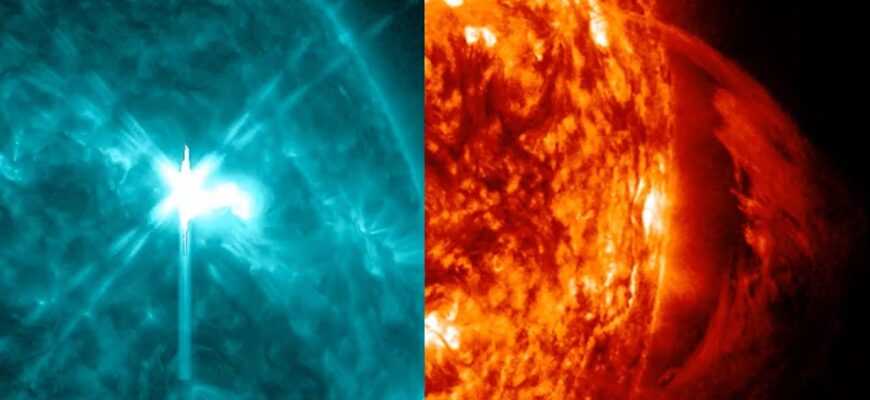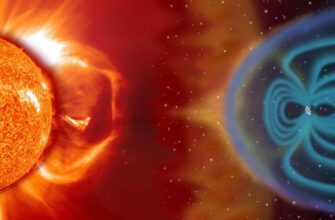After a period of surprising calm, our star, the Sun, has once again decided to remind us of its dynamic nature. The early hours of August 7, 2025, marked yet another notable event in a recent series of solar eruptions: an M2.2 class flare originating from active region 4168. This event, confirmed by the Solar Astronomy Laboratory of the Space Research Institute of the Russian Academy of Sciences (IKI RAS), signifies a distinct uptick in solar activity.
A Return to Form for Our Dynamic Star
For roughly a month and a half, the Sun had been remarkably quiet, offering a serene, albeit temporary, reprieve from the spectacular energy bursts it is known for. However, this period of tranquility abruptly ended on August 3, 2025, with the first of several M-class flares. The most potent of these recent emissions registered as an M4.4 flare on August 5, setting the stage for the subsequent M2.2 event.
Understanding M-Class Flares: Not Just a Light Show
So, what exactly does an “M-class” flare signify? Solar flares are colossal bursts of radiation from the Sun`s surface, often associated with sunspots – regions of intense magnetic activity. They are classified into categories based on their X-ray flux measured near Earth, specifically in the 1 to 8 Angstrom range:
- A, B, C-class: These are the weakest and most common, often going unnoticed.
- M-class: Considered moderate flares, M-class flares are ten times more powerful than C-class flares. While not usually directly harmful to humans on Earth, they can cause some interesting effects.
- X-class: These are the most intense flares, ten times stronger than M-class, and can have significant impacts on Earth and space infrastructure.
The recent M2.2 and M4.4 flares, while not X-class behemoths, are certainly strong enough to warrant attention from space weather forecasters and anyone reliant on satellite technology.
The Terrestrial Ripple Effects
When an M-class flare erupts, it releases a torrent of X-rays and ultraviolet radiation that reaches Earth at the speed of light. This burst of energy can:
- Disrupt Radio Communications: Particularly High-Frequency (HF) radio signals used for aviation, maritime, and amateur radio can experience sudden blackouts on the Sun-facing side of Earth. Imagine trying to coordinate an urgent flight, only to find your communications suddenly vanish. A minor inconvenience for some, a critical issue for others.
- Impact Satellite Systems: Satellites orbiting Earth, especially those in geosynchronous orbit, can be exposed to increased radiation. While most are designed to withstand such events, a series of strong flares can degrade performance or even cause temporary malfunctions. Our modern world, heavily reliant on GPS, satellite TV, and countless other services, is subtly vulnerable to the Sun`s whims.
- Fuel Aurora Displays: For those fortunate enough to live near the poles, these flares, especially if accompanied by a Coronal Mass Ejection (CME), can enhance the spectacular Northern and Southern Lights. A beautiful side effect of the Sun`s temper tantrum.
The Watchful Eyes of Science
The timely reporting of these events by institutions like the Solar Astronomy Laboratory of IKI RAS underscores the critical importance of continuous solar monitoring. With an increasing number of satellites in orbit and our society`s growing dependence on space-based technology, understanding and predicting space weather events has become a cornerstone of global infrastructure safety. These laboratories track sunspot regions, analyze flare intensities, and model potential impacts, providing crucial data for everything from astronaut safety to power grid management.
The Solar Cycle Continues Its March
This resurgence in M-class activity is a strong indicator that the Sun is progressing towards or is already within the peak of Solar Cycle 25. The solar cycle is an approximately 11-year period during which the Sun`s activity fluctuates, moving from a minimum (few sunspots, fewer flares) to a maximum (many sunspots, more frequent and powerful flares) and back again. The current increase in flare frequency and intensity aligns perfectly with predictions for an active solar maximum, promising more celestial fireworks and, perhaps, more radio disruptions to keep us on our toes.
In Conclusion: A Cosmic Reminder
The Sun, our life-giving star, is far from a static, unchanging orb. It is a dynamic, complex entity, capable of both sustaining life and, occasionally, throwing a powerful stellar punch. While the recent M-class flares might not grab headlines in the same way as a full-blown X-class eruption, they serve as a valuable reminder of our planet`s intimate connection to its star. And for those of us living on Earth, it’s a good thing there are dedicated scientists constantly monitoring the Sun`s moods, ensuring we`re always prepared for whatever cosmic weather it decides to send our way.







